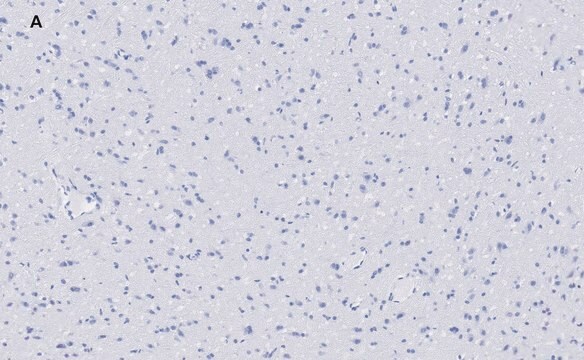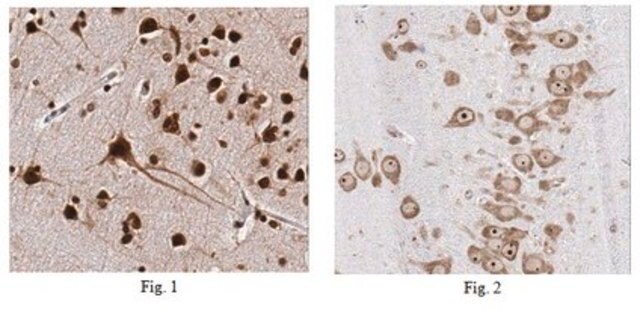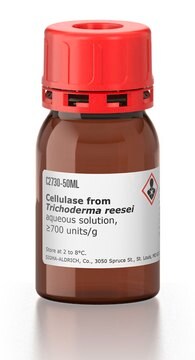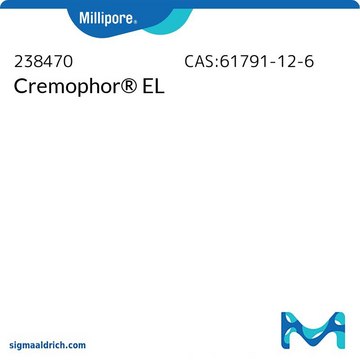ABN1647
Anti-Vesicular Glutamate Transporter 1 Antibody
rabbit polyclonal
Sinónimos:
Vesicular glutamate transporter 1, Brain-specific Na(+)-dependent inorganic phosphate cotransporter, Solute carrier family 17 member 7
About This Item
Productos recomendados
Nombre del producto
Anti-VGluT1, from rabbit
origen biológico
rabbit
Nivel de calidad
forma del anticuerpo
unpurified
tipo de anticuerpo
primary antibodies
clon
polyclonal
reactividad de especies
mouse, human, rat
reactividad de especies (predicha por homología)
bovine (based on 100% sequence homology)
envase
antibody small pack of 25 μL
técnicas
immunoautoradiography: suitable
immunofluorescence: suitable
immunohistochemistry: suitable
western blot: suitable
isotipo
IgG
Nº de acceso NCBI
Nº de acceso UniProt
Condiciones de envío
ambient
modificación del objetivo postraduccional
unmodified
Información sobre el gen
human ... SLC17A7(57030)
Descripción general
Especificidad
Inmunógeno
Aplicación
Immunohistochemistry Analysis: A representative lot detected VGLUT1 in prefrontal cortex of a representative control subject and AD patient (Kashani, A., et. al. (2008). Neurobiol Aging. 29(11):1619-30).
Western Blotting Analysis: A representative lot detected VGLUT1 in glutamate transporter 1 in rat and human putamen extracts (Kashani, A., et. al. (2007). Neurobiol Agining 28(4):568-78) and prefrontal cortex of controls, MCI, early stage Alzheimer (Kashani, A., et. al. (2008). Neurobiol Aging. 29(11):1619-30).
Immunofluorescence Analysis: A representative lot detected VGLUT1 in mouse striatum and hippocampus tissue (Courtesy of Dr.Salah el mestikawy PhD, at DR1 CNRS (CENTRE NATIONAL DE LA RECHERCHE SCIENTIFIQU - SATT LUTECH).
Immunofluorescence Analysis: A representative lot detected VGLUT1 in rat striatum (Herzog, E., et. al. (2001). J Neurosci. 21(22):RC181).
Immunoautoradiography Analysis: A representative lot detected VGLUT1 in coronal sections of frontal rat brain (Herzog, E., et. al. (2004). Neuroscience. 123(4):983-1002) and rat brain sagittal sections (Herzog, E., et. al. (2001). J Neurosci. 21(22):RC181).
Western Blotting Analysis: A representative lot detected VGLUT1 in BON cells stably expressing VGLUT1 (Herzog, E., et. al. (2001). J Neurosci. 21(22):RC181).
Neuroscience
Calidad
Western Blotting Analysis: A 1:1,000 dilution of this antibody detected VGLUT1 in 20 µg of mouse brain tissue lysate.
Descripción de destino
Forma física
Almacenamiento y estabilidad
Cláusula de descargo de responsabilidad
¿No encuentra el producto adecuado?
Pruebe nuestro Herramienta de selección de productos.
Código de clase de almacenamiento
12 - Non Combustible Liquids
Clase de riesgo para el agua (WGK)
WGK 1
Punto de inflamabilidad (°F)
Not applicable
Punto de inflamabilidad (°C)
Not applicable
Certificados de análisis (COA)
Busque Certificados de análisis (COA) introduciendo el número de lote del producto. Los números de lote se encuentran en la etiqueta del producto después de las palabras «Lot» o «Batch»
¿Ya tiene este producto?
Encuentre la documentación para los productos que ha comprado recientemente en la Biblioteca de documentos.
Los clientes también vieron
Nuestro equipo de científicos tiene experiencia en todas las áreas de investigación: Ciencias de la vida, Ciencia de los materiales, Síntesis química, Cromatografía, Analítica y muchas otras.
Póngase en contacto con el Servicio técnico









